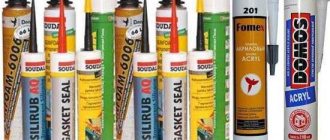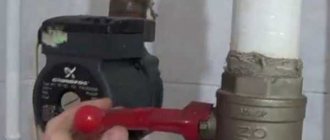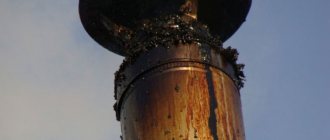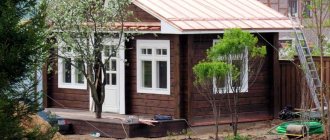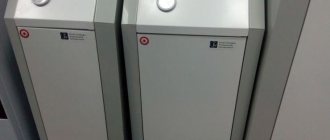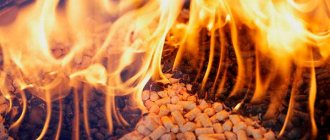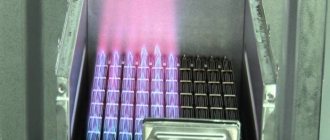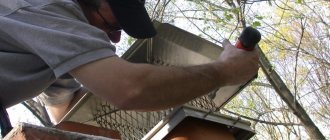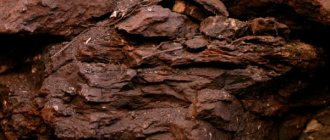Reasons for the boiler being blown out by the wind
If in apartment buildings the heating system is mounted in a coaxial air duct, which prevents wind from entering it, in private houses the problem of attenuation during strong gusts occurs quite often.
This is due to the design features of the chimney, as well as predisposing factors:
- There are trees near the air duct - with strong gusts of wind, vortex gusts are created that change the draft in the chimney, which leads to vibrations of the burner wick and, accordingly, the flame disappears.
- The predominance of downward wind flows, as well as the incorrect level and height of the chimney - this is especially true for lonely private houses (dachas, cottages), next to which there are no other buildings.
- Insufficient chimney height , at which a gusty wind easily extinguishes the burner flame.
- Malfunction of the draft sensor , which gives false readings, triggering the operation of the automation, blocking the supply of gas to the combustion chamber.
- Depressurization of the chimney , in particular an open inspection hole, which forms a reverse draft and triggers draft control sensors, which signal the need for an emergency shutdown of the gas supply to the system.
- Incorrect chimney design , when the required number of turns is missing and the wind from outside easily enters the boiler.
Also, the cause of boiler extinguishing in strong winds can be reverse draft. If the boiler is installed near a balcony door, in a gusty wind, when the door is open, a strong draft will be created, which will lead to vibration and extinguishing of the wick.
The burner flame has blown out - we solve the problem with the chimney
If your autonomous gas boiler constantly blows out, first look for problems in the chimney design. Pressure drops in a gas pipe occur extremely rarely, and the pressure drop is insignificant. A technical malfunction of a gas boiler, due to the simplicity of the design of heating equipment and the high degree of reliability of modern models, is also unlikely.
The most common situations encountered related to the chimney:
- ice crust covering the ventilation duct of the heating device - the formation of an ice cap inside the chimney prevents air circulation, putting the gas boiler in a state of oxygen starvation (along with combustion products, water vapor enters the chimney duct, condensing and freezing on the walls of the chimney);
- reverse draft that occurs when the wind increases or changes direction (a strong air flow, entering the chimney, reaches the combustion chamber and extinguishes the flame in the boiler).
In the first case, frozen condensate creates an artificial obstacle to the air flow. In such a situation, the chimney must be cleaned and insulated, allowing the condensate to simply drain down.
In the second case, the situation is dangerous. With the reverse movement of warm air, strengthened by gusts of wind, there is a high probability of the burner flame extinguishing. Good automation will work when the burner goes out, stopping the gas supply to the firebox. However, combustion products will first enter the heating device, contaminating the combustion chamber in the gas boiler, and then begin to enter the living space. The reason for this effect is obvious - the insufficient height of the chimney.
How to identify the problem?
Since the boiler can go out due to all sorts of malfunctions, you can understand that the wind was the cause by the following signs:
- The boiler stops working only in strong winds, but on other days it works properly.
- Oscillation of the burner flame towards the exit, change in its height in the presence of strong wind outside. Normally, external factors do not a priori affect the operation of the boiler and burner in particular.
- A pronounced whistling sound in the combustion chamber, which changes its intensity and severity with different gusts of wind and completely disappears in calm, windless weather.
Expert opinion
Filimonov Sergey Vinokurovich
Heating equipment repairman
I also recommend monitoring such a parameter as gas pressure in the system. If the boiler is set to minimum values, then it is more susceptible to being blown out by the wind than a boiler set to medium values. Often the problem can be solved simply by adding power to the heating system. If this does not help, then you need to consider the situation from all possible sides.
Repair of wall-mounted and turbocharged units
Wall-mounted gas boilers with open and closed combustion chambers are more complex devices equipped with modern electronics and safety elements. But here, too, some problems can be solved on your own. All the manipulations described above with checking traction, fuel supply and sensors are just as relevant for wall-mounted atmospheric heat generators.
To find faults in a wall-mounted electric gas boiler, you need to arm yourself with the product’s operating instructions and a Phillips screwdriver; you are unlikely to need other tools. The technical data sheet contains the fault codes displayed on the heater display, and a screwdriver is needed to remove the front panel.
There are 3 non-working states of the heat generator:
- The boiler is completely turned off, not a single indicator lights up.
- The unit is turned on, the display and power indicator are on, but automatic ignition does not occur.
- There are attempts to start the main burner, but after ignition it immediately goes out.
The fuse box is located on the electronic board of the boiler.
Having made sure that voltage is supplied to the heater, we can begin to repair condition No. 1. To do this, unscrew the front panel of the gas boiler with a screwdriver or an asterisk wrench and remove it or fold down the front cover (depending on the model). Then the algorithm is as follows:
- Locate the fuse box and check each one with a multimeter or visually. Surely there will be one that is burned out.
- As a rule, the spare fuse is glued to the inside of the front panel. Put it in place of the burnt one or buy a new one (exactly the same value!).
- Try starting the heating unit. If it works, then the repair is complete, put the cover back in place.
- Did the device turn on and “die” again? All that remains is to call a technician, since the problem is more serious.
In the other two non-working states, the display shows an error code, by which you can determine the problem by looking at the product data sheet. The expert recommends the following: when the documentation says “contact service” next to the error code, then that’s what you need to do; you won’t be able to handle the breakdown yourself. You can resolve the following errors yourself:
- The sump filter that filters the coolant from the heating system is clogged. Disconnect the heat generator from the house electrical network, turn off the taps and clean the element mesh.
- The built-in circulation pump does not work. The reasons are jammed rotor or air lock. In both cases, unscrew the large screw (located in the center of the pump) and release the air or turn the rotor with a screwdriver. Be careful, some water will flow out of the hole.
- When the boiler pressure gauge shows low pressure and there are no leaks in the heating system, you need to pump air into the expansion tank mounted inside the heating unit. The pressure on the air side of the membrane should be 0.2 bar less than in the system. Read more about pumping up the tank here.
- If a leak is detected at low pressure, it must be repaired and then added to the water system.
Boilers with coaxial chimney
If a gas boiler has a side chimney (usually in apartments) and goes out due to strong gusts of wind, the main reason lies in the formation of condensation and ice. In practice, the situation is as follows: when exhaust gas exits into the pipe, it cools very quickly and settles on the internal walls in the form of an ice crust, which rapidly increases in thickness.
Outwardly, this does not manifest itself in any way, with the exception of a few icicles hanging outward from the pipe, but in reality the natural removal of waste products is disrupted, which negatively affects the operation of the boiler itself. Whirls are created that lead to oxygen starvation of the gas chamber, and accordingly the gas combustion process is disrupted or completely stopped.
The problem often occurs in regions where winter temperatures are more than -30°C. Experts recommend installing insulation on the outside of pipes to minimize condensate icing. In case of significant ice accumulations, mechanical defrosting using special devices is required, so it is better to call the gas service to solve this problem.
If the design features of a boiler with a side chimney do not require a deflector, then you should install it yourself. This is necessary in cases where the number of windy days per year is more than 200. A device that cuts off vortex air flows. Installed on the air intake pipe.
The gas boiler is blown out by the wind, what should I do?
Often the reason why a gas heating boiler stops working is due to wind blowing. Its shutdown in winter is a very unpleasant surprise for the owners. This can lead not only to a sharp decrease in the temperature inside the house, but also to damage to the entire heating system. Let's deal with the problem.
If your gas boiler suddenly turns off, do not panic and first rule out such a possible cause as a sharp decrease in gas pressure in the pipeline. To do this, you can simply turn on the gas stove and look at the flame, its size, and check how quickly the water boils. You will immediately notice low gas pressure on the hob. In this case, your boiler is definitely not to blame; call the gas workers and find out the causes of the problem. Most likely, not only you have it, but also all your neighbors.
In addition, check and eliminate the possibility of gas leaks using a soap solution, which is applied with a sponge or spray bottle to the joints of pipes and parts. There is no smell or bubbles, which means there is no leakage.
However, often the reason for the gas boiler turning off is obvious - there is a hurricane wind outside, which simply whistles in the pipes. Strong gusts of wind entering the chimney cause reverse draft, the valve is activated, and the flame in the boiler automatically goes out.
You should think about preventing the risk of the boiler blowing out even at the stage of installing the chimney. It is highly advisable to take into account the wind rose in your region. A chimney that is incorrectly located relative to the wind pressure zone significantly increases the risk of the boiler burner blowing out. Incorrect chimney pipe configuration can also cause this problem.
A deflector installed on the head of the chimney pipe copes well with the problem of the boiler blowing out. This is a fairly simple design that increases draft in the chimney, protects it from precipitation and blowing. Be sure to think about installing a deflector or immediately purchase a design with such a device.
Important! Actions with gas equipment require coordination with the relevant service. Therefore, before installing a deflector or weather vane, consult with gas specialists. The cause of a gas boiler blowing out can also be the burning of a metal chimney pipe
As a result of burning, a hole is formed into which air flows - problems with the chimney appear. Only replacing the pipe will help cope with the situation. In the case of coaxial chimneys, there is no risk of burnout, because the hot gas from the boiler flows through the internal pipe, cooled by the oncoming cold air flow
The cause of a gas boiler blowing out can also be a burnout of the metal chimney pipe. As a result of burning, a hole is formed into which air flows - problems with the chimney appear. Only replacing the pipe will help cope with the situation. In the case of coaxial chimneys, there is no risk of burnout, because the hot gas from the boiler flows through the internal pipe, cooled by the oncoming cold air flow.
Two more possible reasons for a gas boiler blowing out:
Ice formation on the chimney. This often happens with coaxial structures in frosts of -10..-15 °C. Hot steam comes out of the chimney, gradually cools, turns into water droplets, condensation, which freezes, forming icicles and a thick layer of ice. This leads to a disruption in draft, the boiler automation is triggered, and it stops working. If such a problem arises, do not rush to knock off the ice build-up - you can damage the chimney itself. It is best to remove the head and upper part of the pipe and bring it into a warm room so that the ice melts naturally. Before removing and cleaning the pipe, the gas supply must be turned off! Additional insulation of the chimney helps to avoid the appearance of ice;
Poor ventilation in the boiler room can lead to problems with the operation of the atmospheric boiler. It will help to install forced ventilation in the room or holes with a fine mesh at the bottom of the boiler room door.
Manipulations with the pipe help to cope with the boiler blowing out - the diameter of its outlet can be reduced or increased in length. A chimney opening that is too large can be reduced by installing an additional inner pipe. Remember that the vertical chimney must be 50 cm higher than the roof ridge.
In this case, too long a chimney can cause excessive, strong draft, which will literally tear the flame away from the boiler burner.
We strongly advise you to call specialists if problems arise in the operation of your gas boiler! Only they will be able to accurately determine the reason for the device shutdown and eliminate it.
Increasing the length of the chimney
Increasing the height of the chimney is appropriate when there are other buildings or tall trees near the house that affect the draft in the chimney. The procedure involves putting several pipes with a cross-section 0.5 larger than the chimney itself onto the existing chimney pipe. It is important to remember that the height of the chimney depends entirely on the roof structure and the power of the boiler.
The average height of the chimney from the boiler grate is 5-6 m. This value can be increased taking into account the roof surface.
Only professionals should carry out work to increase height, as there is a risk of getting the opposite effect:
- A high chimney provokes increased draft, so most of the heat will literally “fly out into the chimney.”
- The amount of condensate increases, which at subzero temperatures will freeze on the inner wall of the chimney. This is fraught with disruption of natural air exchange and automatic shutdown of the gas supply.
Expert opinion
Filimonov Sergey Vinokurovich
Heating equipment repairman
I recommend installing traction stabilizers or dampers, with which you can manually adjust the traction and increase it in especially windy weather.
Making a deflector
The simplest version of a deflector such as a Volpert-Grigorovich device is quite easy to make with your own hands.
Required tools and materials
- Marker or felt-tip pen.
- Ruler.
- Iron scissors.
- Mallet.
- Wooden beam for stand.
- Riveting device.
- Drill, metal drills (or drill-tip screws).
- Galvanized iron sheet 0.3–0.5 mm thick (aluminum sheet or thin stainless steel is suitable).
- Metal parts that are available: corner, studs, thick wire and the like.
Size calculation and diagram
Since the quality of the deflector depends on the accuracy of manufacturing, drawing up the correct drawing is the most important step in the entire process. The dimensions were verified by scientists in a wind tunnel, and they must be followed. The parameter to start from is the diameter of the chimney channel D.
The dimensions of all parts of the deflector are set in proportion to its diameter
Table: dimensions of deflector parts relative to its diameter
| Index | Coefficient in relation to diameter |
| Lower diffuser diameter | 2 |
| Upper diffuser diameter | 1,5 |
| Diffuser height | 1,5 |
| Recessing the pipe inside the diffuser | 0,15 |
| cone height | 0,25 |
| umbrella height | 0,25 |
| reverse cone height | 0,25 |
| Gap between umbrella and diffuser | 0,25 |
Instructions for making a deflector with your own hands
- We transfer the drawn details onto cardboard and make a cardboard mock-up. We check that the parts match each other.
- Let's open the layout back up. We trace this cardboard pattern, placed on a galvanized sheet, with a marker.
- We cut out all the details with iron scissors.
- We roll up the casing and drill holes in its edges.
- We fasten the casing with rivets (or we don’t drill or fasten it, but use drill-tip screws).
- In the same way, we fasten the lower and upper cone plates in turn.
- The top plate is larger, so we cut 6 tabs in its edge to attach to the bottom plate.
- We attach studs to the bottom plate to connect to the casing.
- We use them to attach the umbrella to the casing.
- To secure the finished deflector to the chimney, it is better to separate the top part of the pipe and connect it to the deflector on the ground. The strength of this connection is extremely important. The wind load at altitude will be great and can interfere.
The deflector may not be very beautiful, but you will immediately feel its usefulness: the draft will increase by a quarter, the roof will be protected from sparks. The pipe with it can be one and a half to two meters lower.
Video: DIY production of a TsAGI deflector
When installing any traction booster, you will immediately feel the benefits. But a deflector made with your own hands will also create a significant reason to make you proud of yourself.
Deflector installation
The deflector is an aerodynamically shaped nozzle that fits onto the chimney. Made from stainless or galvanized steel.
Performs several functions simultaneously:
- Protects against debris, precipitation and dust getting into the chimney - it has a cone-shaped top.
- Blocks gusts of wind, cutting them off - preventing the vortex from entering the chimney.
- Increases draft by 10-20%, which allows you to solve the problem without increasing the height of the chimney pipe.
The process of installing the deflector will not cause any difficulties, and the effectiveness can be assessed almost immediately. In regions where winds prevail, this design is necessary and is included in the gas heating system.
There are several types of deflectors, each of which has its own characteristics, advantages and disadvantages.
TsAGI
TsAGI
Metal pipe with a shielding cylinder. It has a protective cone inside that prevents blowing from the top and sides.
Advantages:
- Protects from precipitation
- Prevents debris from entering the pipe
- Easy installation
Flaws:
- In severe frosts it provokes the formation of heavy ice
Grigorovich deflector
Grigorovich deflector
A truncated cone with a widening at the base and a mushroom-shaped lid at the top. The air flow enters under the top cover, discharging the air and increasing traction.
Advantages:
- Protects against debris and precipitation
- Relatively low cost
Flaws:
- Not effective in low winds
Vane deflector
Vane deflector
Contains a weather vane and several metal canopies that rotate in the direction of the wind.
Advantages:
- Enhances natural cravings
- Protects against blowing from all sides
- Blocks sediment from entering
Flaws:
- Not found
Expert opinion
Filimonov Sergey Vinokurovich
Heating equipment repairman
The choice of deflector depends on the power of the gas boiler and the characteristics of the chimney. If it is selected incorrectly, the gas consumption will increase and the heat in the house will decrease. To eliminate this, you need to contact specialists and carry out work in compliance with the recommended standards.
Installation of a specially designed deflector
To achieve maximum results when solving the problem of what to do if the boiler goes out in the wind, a specially designed deflector - an aerodynamic device installed on the chimney - allows you to achieve the maximum result.
In a simple deflector, the main function is performed by the outer part, which is affected by the air flow. At the point of contact of the air flow with the surface, a rarefaction zone is created, which increases the draft in the chimney duct. As a result of using a simple deflector, thrust can be increased by 15-20 percent. Consequently, devices with a more complex design will be much more effective.
Complex structures are installed when the use of a conventional deflector does not help solve the problem of the boiler being blown out by gusts of wind. From a large number of complex design deflectors, there are several types that are most often found on the consumer market:
- Deflector "Smoke tooth".
- Grigorovich deflector.
- Deflector "Voller"
- The deflectors are spherical and rotating.
The leader among the listed options is the Grigorovich deflector, so a little attention can be paid to its design.
This device has a special design, in which every contour and element is directly related to aerodynamics. If a simple deflector installed on the pipe of a private house is made in the shape of an umbrella, then the Grigorovich deflector is distinguished by the presence of a direct and reverse cone. Due to their interaction, the necessary movement of air flows is created, as a result of which a zone of low pressure is created around the chimney. The different temperatures of hot and cold air flows greatly increase the draft in the chimney duct and prevent the penetration of air from outside into the pipe.
Deflectors with a complex design force strong gusts of wind to increase draft in the chimney duct. In any case, air masses fall under the lower cone of the deflector and suck in the flow coming from the boiler into the chimney channel.
The correct location and design of the chimney in combination with a complex design deflector allows you to solve the problem of backdraft. Thanks to this, gusts of wind of any strength do not blow out the flame of the boiler burner, but only increase the draft in the chimney channel, allowing the equipment to operate more efficiently.
Particular attention should be paid to the situation when the gas boiler goes out due to wind, and starting the heating system does not give a positive result. In this case, the cause is an insufficiently heated chimney
Country houses and cottages are rarely visited, so the heating system does not function for a long time. As a result, the first start of the heating boiler does not lead to anything; the burner flame goes out after a short period of time. Many owners wonder what is the reason for this behavior of gas heating equipment. The fact is that waste combustion products rise up a cold chimney with great difficulty, and a gust of wind of any intensity does not allow the duct to warm up.
To solve this type of problem, you need to turn on the boiler at minimum power and warm up the chimney duct. In this case, the power of the device gradually increases to certain values. As a result, the hot stream with fuel combustion products rises naturally.
When creating an efficient heating system in a private home, competent calculations when drawing up a project are of great importance.
However, the ventilation system in this case is no less important. Correctly chosen design and high-quality installation of ventilation will ensure uninterrupted operation of heating equipment
Saving on exhaust and ventilation when deciding what to do to prevent the boiler from blowing out can give a negative result during operation
Therefore, you should pay special attention to the ventilation system when planning your house, otherwise the aesthetic appearance may turn into discomfort in the winter. There will be a need to re-equip the chimney duct and climb to the roof in any frost
Gradual heating of the boiler
If a gas heating system is used in country houses and has been inoperative for a long time, even weak gusts of wind can cause the flame to die out.
The problem is solved by gradually heating the boiler, namely, first after ignition, set the minimum temperature, after 5-10 minutes add gas, and after 20-30 minutes warm up the chimney at high settings. This will allow the chimney to fully warm up, which will make it easier for the exhaust gas to escape up the chimney.
How to deal with backdraft. Basic mistakes and misconceptions
It was previously said that backdraft can be combated by increasing the length of the chimney. The solution to the problem is quite simple, but such a solution does not always give positive results.
The second solution to the problem in such a situation is to install a deflector on the upper edge of the chimney, the task of which is to increase the draft in the chimney.
The third option is to reduce the number of bends and sharp turns of the chimney, which increase cavitation (vortex) of the flow of hot air with smoke as it passes through the pipe.
In both the first and second cases, the situation will not change radically. Extending the pipe by 1 meter will not give the expected effect. Installing a deflector on the chimney also does not completely solve the problem. If the weather worsens significantly, the wind will still blow out the unprotected gas boiler, and the heating will fail again. What to do? What is the optimal solution?
A specially designed deflector is a solution to the problem
An effective method that can solve the problem of reverse draft once and for all is to install an aerodynamic device on the chimney - a deflector of a special design.
In a conventional deflector, air flows act on its outer part. As a result of the interaction of the air mass with the surface of the deflector, a rarefied atmosphere is created, which increases the draft in the chimney. The phenomenon is called the Bernoulli effect, the concept of which came to us from aviation. In other words, when air encounters an obstacle and bends around it, a rarefaction zone is created around the obstacle, enhancing the lifting effect of the wing.
If a conventional deflector is not able to eliminate wind blowing of a gas boiler, a device of a more complex design is installed. Today there are several types of deflectors with complex configurations. Among the most popular products, the following types should be highlighted:
- “Smoke tooth” type deflector;
- Grigorovich deflector;
- "Voller" type deflector;
- spherical and rotating deflectors.
Two types of devices are considered the most popular in our country: the Grigorovich deflector and “smoke tooth” devices.
The Grigorovich deflector is a device in the design of which all contours and elements are directly related to aerodynamics. Unlike the usual umbrella-shaped deflectors we are used to, standing on pipes in private homes, this device has two cones, direct and reverse. The interaction of the two cones ensures the necessary movement of air flows, thereby creating a zone of low pressure around the chimney. Due to the temperature difference between the cold and hot flows, the draft in the pipe increases several times, preventing any penetration of outside air inside.
With the correct location and design of a chimney equipped with a deflector, backdraft will not threaten you - any gusts of wind will not be a problem for a working boiler.
Another point worth noting is when the wind blows out the gas boiler and the heating system does not start. We are talking about an insufficiently heated chimney. During long shutdowns of the heating system, which is typical for country houses and cottages, when the boiler is first started, the burner flame often quickly extinguishes. The explanation for this behavior of gas heating equipment is quite simple - it is difficult for waste combustion products to rise up a cold chimney, and any gusts of wind only hinder the heating of the channel.
To get out of this situation, it is enough to warm up the chimney at low boiler operating modes, gradually increasing the power of the device to optimal parameters, and the hot combustion products in the heated chimney will rush upward naturally.
General tips and tricks
If the gas boiler is blown out by the wind, pay attention to the following nuances:
- Check to see if the boiler is operating at minimum temperatures. It makes sense to add gas by 20-30% to enhance natural traction.
- Be sure to call specialists who will not only find the problem, but also diagnose the entire heating system.
- Clean the chimney in a timely manner, as contaminants can form inside over time.
It is not recommended to independently inspect the combustion chamber, change burner parameters or adjust the operation of control sensors. This may lead to problems in the future. All work related to gas equipment must be carried out by qualified specialists.
We make sure that the burner goes out due to the wind
In order not to waste efforts in vain, which sometimes happens in practice, it is worthwhile to accurately determine the reasons for the burner extinguishing, since this could be an automatic error, low gas pressure, or difficulties with the removal of combustion products. Characteristic signs of wind blowing are:
- visual changes in the shape and direction of the flame caused by the wind;
- characteristic sound of a vortex in the combustion chamber;
- the burner does not turn off without reason in calm weather, this item must be checked.
A common cause of fading is low gas pressure in the line or incorrect flame height. At low gas pressure, the flame decreases and drops critically low to the burner. To prevent it from burning out, the automation turns off the burner and the boiler goes out. The normal flame height is considered to be 2-4 cm. If the burner flame height is less, it is necessary to adjust it, but we do not recommend doing this yourself; for this it is better to call the gas service.
It is also necessary to check the tightness of the connections and the entire chimney structure. First of all, if there is an inspection hole in the chimney, pay attention to it: it must be closed and hermetically sealed. If this is not possible, it is worth purchasing a modern sealed plug.
Frequently asked questions and answers
The boiler is blown out by the wind, and the smell of gas is felt in the room. What is this connected with?
There may be a problem with the backdraft valve, but to be sure, it is necessary to inspect the injector burner. Attention should also be paid to control sensors. Over time, they fail and are not able to timely generate a signal about the need for an emergency shutdown of gas supply to the system, which is where the characteristic odor appears.
The flame in the burner is unstable, fluctuates with any gust of wind, often goes out, the temperature in the system drops, what could be the problem?
This is characterized by an increase in natural cravings, for which there are many reasons. It is necessary to inspect the hood, as well as the burner itself, adjusting the gas supply and flame height. If there are strong gusts of wind outside and the problem with attenuation occurs very often, a deflector is installed on the hood (chimney) to cut off vortex air flows.
In conclusion, it is worth noting that the problem with the boiler blowing out periodically occurs among residents of apartment buildings. As for private mansions, attenuation is caused by improper chimney design or insufficient draft.
In resolving the issue, it is important to make sure that the burner and control sensors are in good working order, since they can indirectly contribute to stopping the combustion process. All work must be performed by qualified specialists.
General characteristics of the problem
A modern gas boiler is a very complex device. When a gas boiler blows out, various abnormalities in operation can be observed, ranging from startup failure to unexpected stoppage of the burner. For example, the unit may start, and then extinguish the flame a minute later.
In addition to wind, there may be several reasons:
- malfunctions or insufficient pressure in the supply system, poor quality gas;
- The smoke removal system does not work well;
- electrical network leads to diagnostic errors.
Poor operation of the supply system, as well as low-quality gas, lead to failures of the ignition control system; in some boiler models, two factors - wind and poor fuel - work together.
Naturally, the most common reason why a gas boiler blows out is reverse draft, that is, the action of the wind. This factor manifests itself differently for atmospheric and turbocharged boilers. Therefore, if the boiler starts to blow out, you need to act based on its operating principles.
Why does a chimney need a deflector?
Why is reverse thrust bad? The fact is that the difference in air temperature in the house and outside sometimes plays a negative role. If there is insufficient draft, not only does the firewood burn poorly, but smoke and soot also enter the room. Especially when the weather is changeable. In addition to the unpleasant odor, this is fraught with dangerous air compounds for people living inside the house.
It was in order to solve the problem of air blowing in that special deflectors for the chimney pipe were created. And absolutely all types of deflectors have only one principle of operation: they increase the draft in the chimney on the channel by deflecting air flows.
The whole secret is that air flows, when they encounter an obstacle in the form of deflectors, form a zone with low pressure, and the pressure difference in the channel increases. Thanks to this, the air draft in the chimney becomes 20% more effective.
Today, to ensure forced draft, the following deflectors are installed all over the world:
A standard chimney pipe deflector consists of the following main parts:
- external cylinder , which is used as a ceramic, metal, asbestos-cement pipe;
- top glass or diffuser. Its shape expands towards the bottom, just so that it can be conveniently attached to the lower cylinder using special brackets;
- umbrella - a special cone-shaped cap that is installed on top of the diffuser;
- the bottom glass , on which everything rests.
By the way, some deflectors have a small flaw in their design. So, if the wind creates a vortex right in the hood, it will interfere with the exit of smoke from the chimney. For this purpose, an additional reverse cone is specially installed in the umbrella, which reflects such air flows and cuts them at the stage of exiting.
This roofing element is installed so that the wind cannot prevent fuel combustion products from leaving the chimney, but, on the contrary, pulls them out of the chimney, while simultaneously maintaining high-quality combustion of wood in the fireplace or stove. Deflectors are usually installed on the chimneys of heating boilers that burn solid fuel.
They do not need to be installed on gas boilers, in accordance with SNiP “Installation of smoke and ventilation ducts.” The only exception is that a turbo deflector is installed on gas pipes if the temperature of the exhaust gases does not exceed the maximum (200-500 degrees Celsius). In this case, for safety reasons, it is advisable to use special high-temperature nozzles.
General description of the problem
The design of a gas heating unit is very complicated.
Blowing out the boiler often leads to problems with the system, which manifest themselves as the inability to start the device or spontaneous termination of operation. Sometimes it happens that the burner turns on, and after a couple of minutes it goes out. The reason for this is mainly a strong wind flow, but there are others:
- lack of the required level of pressure of the gas mixture;
- gas does not meet the required quality parameters;
- the smoke removal system is not working properly;
- failures in the electrical network, which over time lead to breakdowns of the device.
But one of the most common reasons that lead to the boiler blowing out is the state of reverse draft, in other words, the influence of wind. Much depends on the type of boiler installed: atmospheric or turbocharged, the influence of wind on them is different.
Why does a gas floor-standing boiler blow out when there is wind?
To effectively combat attenuation, you must understand why it happens. There are several reasons for equipment attenuation:
- Close distance to trees.
- The presence of downward air flows.
- The chimney is located lower than required by the requirements and standards.
For modern gas equipment, a common cause of boiler extinguishing is the operation of the check valve. It can be triggered by excessive air pressure coming from outside. The installed sensors react to any changes and when there is strong pressure on the valve, the gas supply stops.
Another option for attenuation is possible when the heating is turned on after a long shutdown. When first turned on, the flame may go out even from a slight breeze. To eliminate the problem, we recommend starting warming up from the weakest mode, gradually adding power.
What type of gas boiler to choose so that the flame does not blow out
The minimum speed of flue gases at which the flame will not be blown out is 6-8 m/s. Flows of heated air entering the chimney move in a spiral. The vortices gradually increase in speed, which reaches maximum intensity at the exit from the chimney.
There are boilers in which the natural movement of flue gases is replaced by forced one. The design of turbocharged models with a closed combustion chamber includes two blower fans. The first one supplies air to the firebox, the second one removes combustion products. It is impossible to blow out a turbocharged unit with wind. Attenuation indicates that one of the failed fans needs to be replaced.
Source
